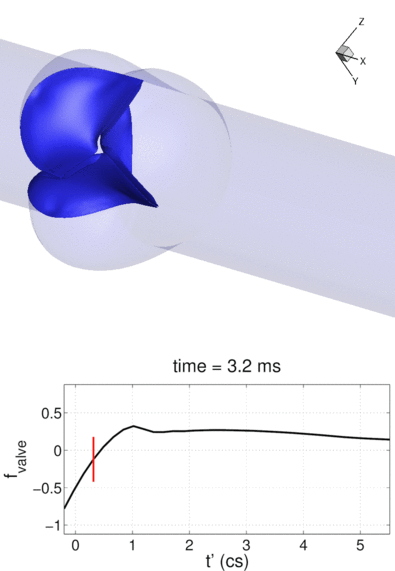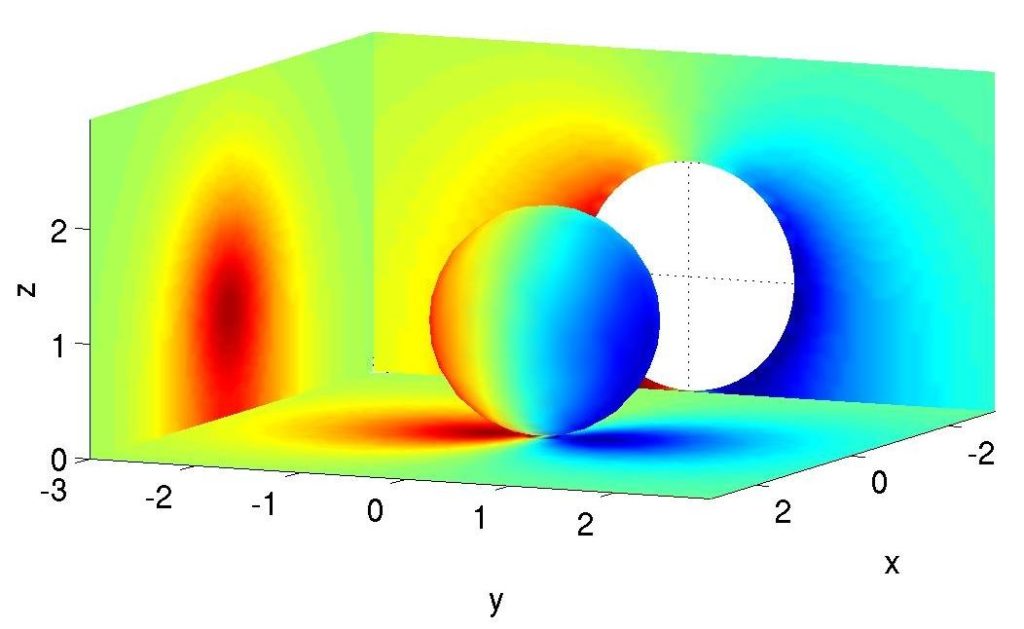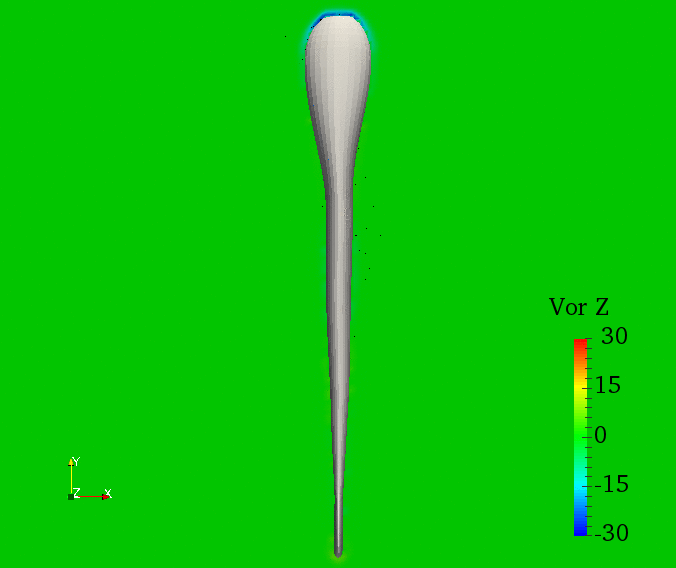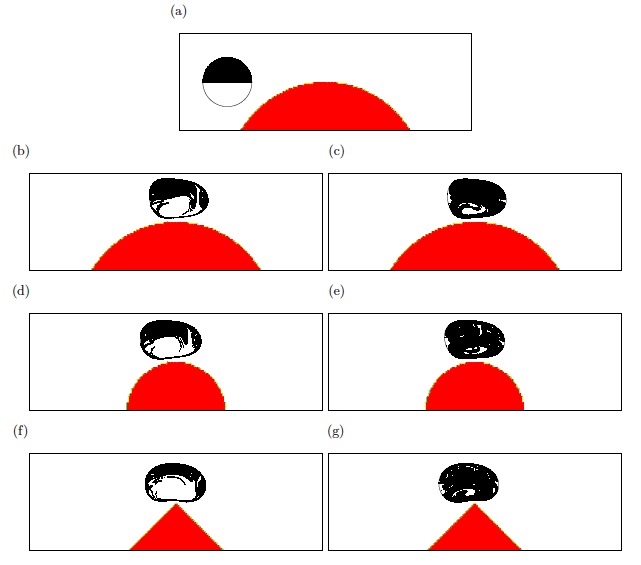Research Projects
1. Fluid dynamics and fluid-structure interaction in biological flying and swimming
Flying and swimming animals, such as insects, birds, and fish, typically possesses superb maneuverability in locomotion. Their flexible propulsors, i.e., wings and fins, interact with the surrounding fluid in a complicated manner that allows them to move amazingly fast and efficiently. Using the state-of-the-art numerical approaches, we model the fluid dynamics and the fluid-structure interaction of these elastic propulsors to understand the fundamental principles of force production and power consumption. Many of these simulations are done on supercomputers using hundreds or even thousands of CPU cores. In addition, we aim to decipher the role wing/fin deformation in the efficiency and maneuverability of the locomotion. We are capable of solving three-dimensional viscous unsteady flows and their interaction with complicated elastic structures. The research results may provide useful information for developing bio-mimetic or bio-inspired aerial and underwater vehicles.
2. Computational modeling of glottal airflow and vocal fold vibration
Voice production process, or phonation, involves aerodynamic interaction of a turbulent glottal jet flow and a pair of three-dimensional vocal folds stretched between the laryngeal cartilages. The pulsatile airflow is responsible for activating and sustaining the vocal fold vibration, and the oscillation pattern of the vocal folds in turn modulates the airflow. The dynamic interaction determines various voice characteristics (e.g., modal voice, breathiness, creakiness, and falsetto). Statistics show that approximately 7.5 million people in the United States have a type of voice disorder. These disorders are debilitating and can lead to discomfort, pain, poor work performance, social withdrawal, and even long-term disability. An advanced computational model of the fluid-structure interaction (FSI) during phonation will find useful applications in the medical research, diagnosis, and treatment of these disorders. For fundamental medical research, the stresses and strains in the tissue calculated from the model can be used to correlate with the changes observed in epithelial morphology, tissue permeability, and inflammatory gene expression, and will thus lead to new explanations for the cause of acute phonotrauma. For clinical diagnosis, including the nonlinear tissue properties allows the researchers to model a wide range of vocal fold dynamics including large deformations and abnormal vibrations, and the computational modeling can be combined with high-speed laryngoscopic imaging techniques to analyze the vibratory patterns of the vocal folds and determine the specific disease. For clinical treatment, the computational modeling of phonation can be used to predict and improve the outcome of implants (e.g., medialization thyroplasty), surgically altered larynges (e.g., injection laryngoplasty), engineered vocal fold tissues, and artificial larynges. For these applications, a high-fidelity simulation tool is needed to accurately account for the 3D fluid/tissue dynamics. Our current focus is to advance patient-specific, high-fidelity computational models to simulate the vocal fold vibration for unilateral vocal fold paralysis (UVFP) patients and optimize the customized implant for each single patient.
 Research on Vocal Fold Modeling
Research on Vocal Fold Modeling
3. Cardiovascular flow and heart valves
Fluid-structure interaction (FSI) of thin leaflets and blood flow is essential for the physiological function of heart valves. However, computational modeling of this FSI problem is notoriously challenging because of the complex geometry and the added-mass effect on the extremely light leaflets. Coupling an immersed-boundary method and the nonlinear mechanics of flexible leaflets, we not only can capture the unsteady vortices but also the dynamic deformation pattern as well as the transient force on the leaflets. Such computational models can be used to build computational tools for diagnosis, assessment, and treatment of heart valve disease.
 |
 |
3D simulation of an aortic valve. Left: leaflet deformation and force on the valve; right: unsteady vortices in the systole phase.
4. Energy storage and water desalination
Dubbed “flowable electrode”, a slurry of porous carbon particles mixed with an aqueous electrolyte has been used in several emerging electrochemical systems, e.g., the electrochemical flow capacitor (EFC) for energy storage and flow-electrode capacitive deionization (FCDI) for water treatment. In a flowable electrode, the activated carbon particles can quickly attract ions in the electrolyte to their surface to form a charged ionic layer called the electric double layer (EDL). With an enormous surface area (>1600 m<sup>2</sup>/g) available for capacitive storage, the flowable-electrode promises to have the advantages of supercapacitors (~10x higher power density, ~100x faster charge/discharge rate, and ~1000x longer lifetimes at potentially lower cost as compared with Li-ion batteries) while retaining great scalability of flow batteries. In our work, we have developed a particle-based simulation tool to model the coupling between the hydrodynamic interactions of particles and the charging process of the flowable electrode. The study will provide in-depth understanding of the microscopic particle behavior in the electrochemical performance of the flowable electrode at the device level.
 Computational modeling of the flowable electrode in an electrochemical flow capacitor
Computational modeling of the flowable electrode in an electrochemical flow capacitor
5. Fast maneuvers of flying and swimming animals
Animals like birds and fish possess superb maneuverability as compared to robots. Using computational modeling, we aim to understand the unsteady aerodynamics or hydrodynamics that enable the animals to perform rapid maneuvers during prey or escape. This research requires our collaboration with biologists as well as researchers who study the control system of these animals. This is an ongoing work. We will have an update soon.
Past Projects
Multiphase flows in complex geometries
Multiphase flows involving two fluids and surface tension arise in a variety of natural and industrial processes, for example, industry processing, pipeline transport, and microfluidic devices. We have developed an immersed-boundary method to simulate two-phase flows in complex geometries, which can handle arbitrary shapes of the solid surface as well as geometrical/topological changes of the fluid-fluid interfaces.
Drops passing through an asymmetric channel. Mixing inside the drops is significantly enhanced.
Electrokinetics and Particle Motions in Microfluidic Channels
The lab-on-a-chip devices have become an exciting research area over the last decade. With integrated microfluidic channels of widths ranging between 1 and 100 µm, the devices can perform specialized functions such as clinical diagnosis, DNA scanning, electrophoretic separation, micro-reaction, cancer cell detection, and bacteria/virus identification. Precise manipulation of particles or cells in the network of microchannels is the key to the performance of the lab-on-a-chip. For example, in cell separation, electrophoresis is used to separate the abnormal cells from a sample fluid containing also the normal cells. To design microfluidic chips for such a process and control the separation with high accuracy and throughput, we need to understand in detail how particles or cells move in electrokinetic flows. We are currently using efficient numerical tools based on the boundary element method (BEM) to investigate the boundary effect on particle motions in electrokinetic flows.
 Disturbance of the electric potential caused by a charged particle near a non-conducting wall.
Disturbance of the electric potential caused by a charged particle near a non-conducting wall.

